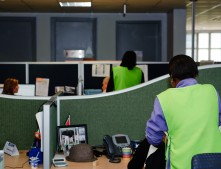A healing touch to the high pressure workplace

Why massage therapy means everything for call centre managers
By Martina Laurie, CEO of Hands On Treatment – The Mobile Massage Company
The advent of social media and the availability of a plethora of media platforms has revolutionised corporate communication. There are simply that many ways for customers to engage service providers and for businesses to reach their market, instantly and continuously – as well as effectively.
Discovery Health offers at least eight different media platforms from which you can choose how to interact with them. Eight different platforms that invite you to complain, feedback, query, resolve or simply comment.
Whilst the icons above may not look familiar to the majority of South Africans out there (only 34% of South Africans are estimated to be online) they are increasingly the interface that invite you to ‘join the conversation’.
Joining the conversation has historically been dominated by the telephone and by companies dictating the mode of communication. Today’s approach and practice however is rapidly diversifying into a multi-channel approach driven by social media usage.
Dimension Data’s 2013/14 Global Contact Centre Benchmarking Report notes that for Gen Y (born 1977-1994), the phone is now their third choice of point of contact, after email and social media. Gen Y would much rather tweet their complaint, or facebook their query, than email which has become “quite passé”, according to 1Stream Director, Bruce Von Maltitz.
On call, under pressure
A quick job search on the internet describes the call-centre manager as being “responsible for delivering high standards of service to customers by making the most effective and efficient use of call-centre staff and technology resources.
They (should be able to) use a range of measurements to monitor, analyze and plan improvements to call-centre performance. To meet these responsibilities, the manager must be a combination of expert service provider, coach, trainer, mentor, motivator and manager” (DMG Consulting).
In 2014 Magnetic North, a Contact Centre solutions company questioned 100 call center managers to find out what they perceived to be their biggest challenges. The list was as follows:
• Developing agent skills-sets (31%): this was the number one concern with 67 percent identifying it as their main priority.
• Managing the customer experience across multiple channels (44%)
• Ensuring technology keeps pace with changing customer behaviour (40%)
• Driving operational efficiency and cost savings (34%)
• Making the transition to a Cloud-based contact solution (28%)
The ever-changing landscape of technology has a significant impact on call centres, yet once distilled, the challenges ultimately come to rest on managing the agents within the context of their technological/customer-led environments.
Thankfully, the increasing number of studies into the correlation between employee wellness and productivity in the workplace is timeous for the developments currently unfolding in call centres. Awesome customer satisfaction incumbent upon happy, motivated staff is indeed possible.
Wellness
The growing trend of wellness in the workplace is partly an attempt to ensure effective productivity, the benefits of which would definitely be felt in the call-centre environment.
The issue is a global one and as more and more data substantiates the connection between employee wellness and productivity, companies and management are starting to reflect and implement strategies to effect wellness. Gareth Pritchard, BPeSA CEO urges that health and wellness are critical issues as they “affect your agent pool, team leaders, productivity and ultimately your bottom line”.
Put very simply, ensuring that agent’s experience personal (psychological, physical, emotional) value in their workplace may be more efficacious than merely incentivising them financially.
Touch
One of the most basic expressions of our humanity is our sense of touch. Studies in psychological research consistently point to the value of human touch as an incredibly valuable non-verbal tool. We are wired to both send and receive emotional signals through non-verbal touch alone.
Touch in the workplace is tricky to put it lightly. Touching your work colleague on the knee is impolitic, as are one too many leers. Fortunately however, touch when used professionally, like corporate massage, is a remarkably simple way of spoiling staff, letting them ‘defrag’ unconsciously and thereby moving closer to a better work productivity. This without having to use what can sometimes be the burden of words. People get tired of listening too.
Massage
Research has found that there were significant reductions in anxiety levels among employees receiving 15-minute weekly massages for 6 weeks versus those who merely had a 15-minute break.
The non-invasive, non-aggressive and caring impact of corporate massage significantly impacts the energy flow in the workplace, which ultimately improves productivity and restores the human element back into a workplace that carries high stress and negativity.
The effects of massage are not going to turn call centers around or metamorphosize agents into super-hero’s.
The fast paced evolution of the tech world and the constancy of human complaint forbid any one solution to the challenges that a call centre faces.
The benefits of corporate massages are “equally real for white and blue collar workers” (many of whom don’t have the time or money to go for massages or other wellness therapies) and that the link between the formal and informal sectors plays into the South African concept of Ubuntu.
